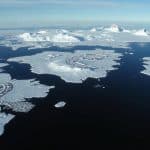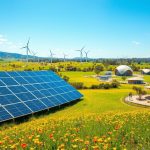Antarctica, an untouched frontier, holds many successful business ventures. These ventures are ready to boost the Antarctic economy significantly. The extreme conditions and unique environment open up unmatched business opportunities. Such opportunities attract innovative minds to various sectors.
Companies now see the value in sustainable practices and advanced technology. These are vital to tackle the region’s challenges and unleash its growth potential. We’ll explore the exceptional business landscape of Antarctica. Let’s highlight the ventures making a significant impact in this remote territory.
The Unique Business Landscape of Antarctica
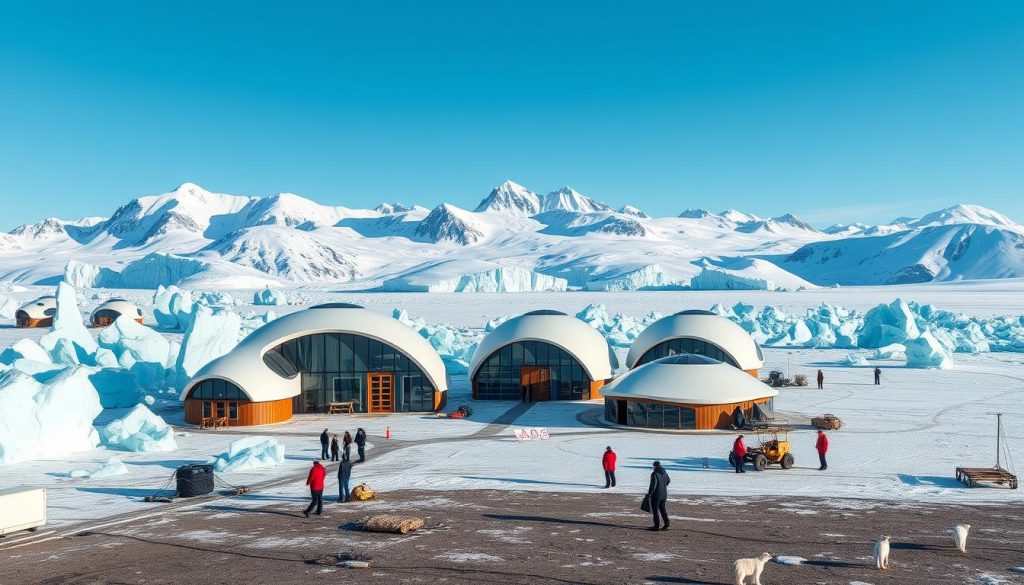
Antarctica is known for its harsh climate and scarce resources. It follows a specific legal system under the Antarctic Treaty. This ensures business activities do not harm the continent’s natural beauty.
The region is rich with untapped resources, sparking interest in scientific studies. These studies open up new chances for business in sustainability and ecological research.
Running a business in Antarctica faces big hurdles. Bad weather can disrupt logistics and operations. Plus, meeting strict regulations is a tough task for companies. Understanding these issues is key for successful investment in this special place.
Successful Business Ventures in Antarctica
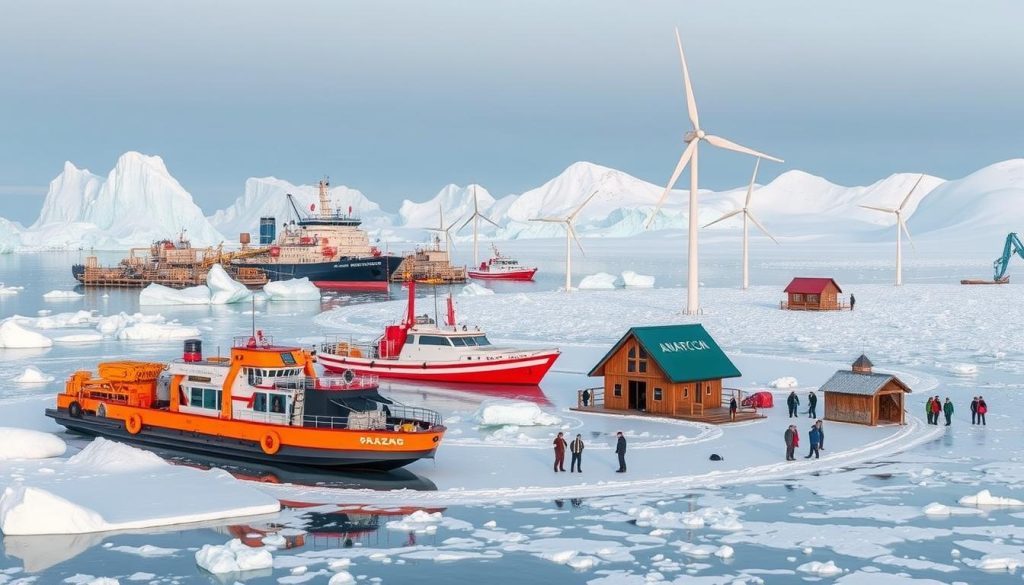
Antarctica’s untouched nature is perfect for new business areas. This continent is now known for its renewable sources and pure landscapes. Many industries in Antarctica are doing well, thanks to their creative and strong business ideas. We’ll look at the main industries below and give examples of businesses doing well there. These examples show how they’ve dealt with challenges and grown.
Key Industries with Growth Potential
Several sectors see Antarctica as a land of opportunity. These significant fields are:
- Tourism: Eco-tourism is becoming popular, offering safe visits to Antarctica’s beauty.
- Renewable Energy: There’s a move to green energy, with advances in solar and wind power.
- Research and Development: Science projects are bringing in money, leading to new environmental tech.
Case Studies of Successful Ventures
Looking at specific examples, we see how firms are doing well in tough conditions. Some successes are:
- Eco-Tourism Ventures: Quark Expeditions, for example, has eco-friendly trips that are kind to the environment.
- Renewable Energy Projects: Companies like Antarctic Renewable Energy Solutions are making progress with wind power, meeting energy demands in a green way.
- Scientific Partnerships: Working with research bases has brought about tech breakthroughs to protect the ecosystem.
Exploring Renewable Energy Opportunities

Antarctica is a unique place for renewable energy projects because of its harsh climate and rich natural resources. Using innovative ideas can help establish sustainable methods. These benefit local work and the whole ecosystem. In this tough environment, solar and wind energy are proving that renewable sources can thrive.
Solar Power Innovations
Special solar panels have been developed for the Antarctic climate. They work well even when it’s dark for a long time in winter. These panels have several important features:
- Use of high-efficiency photovoltaic materials.
- Advanced tracking systems to optimise sun exposure during the day.
- Integration with energy storage solutions to maintain a consistent power supply.
These solar power advancements show how Antarctica can move away from fossil fuels. They make the research stations and local projects more sustainable.
Wind Energy Projects
There’s a push for wind energy in Antarctica due to its strong winds. The goal is to build wind farms that supply clean power and cut costs. Here are some considerations:
- Assessment of wind speed and direction to maximise energy capture.
- Development of robust turbine designs tailored for extreme weather conditions.
- Collaboration with international stakeholders to expand renewable energy infrastructure.
Adding wind energy is a big step towards a greener Antarctica. It shows a strong dedication to protecting the environment for the future.
Tourism: An Emerging Source of Revenue

Antarctic tourism is growing fast, showing the continent’s value as an economic source. Visitors are drawn to unique experiences in this untouched place. It is crucial to adopt eco-tourism strategies. These strategies make sure we can enjoy Antarctica without harming its delicate ecosystems.
Eco-Tourism Strategies
Eco-tourism in Antarctica aims to lower environmental damage while creating unforgettable tourist moments. The main strategies include:
- Controling how many visit sensitive spots to avoid too many people.
- Setting strict rules for how tourists should interact with wildlife to keep animals safe.
- Teaching visitors about how important it is to protect the environment.
- Promoting green practices among those who run tours.
These approaches are key to keeping Antarctica’s stunning environment, allowing travel that cares for local animals and their homes.
Adventure Tourism Developments
Adventure tourism in Antarctica is becoming more popular for those who love outdoor activities in unique locations. Some of the most liked activities are:
- Guided trips to hidden spots showing off the amazing views.
- Tours to see penguins, seals, and whales right where they live.
- Photography trips that catch the amazing landscapes and animals.
These activities not only bring in thrill-seekers but also greatly help the local economy. Strategies for eco-tourism along with adventure tourism are key in making Antarctica a top place to visit. They ensure tourism grows in a way that keeps Antarctica beautiful for the future.
Research and Development Ventures
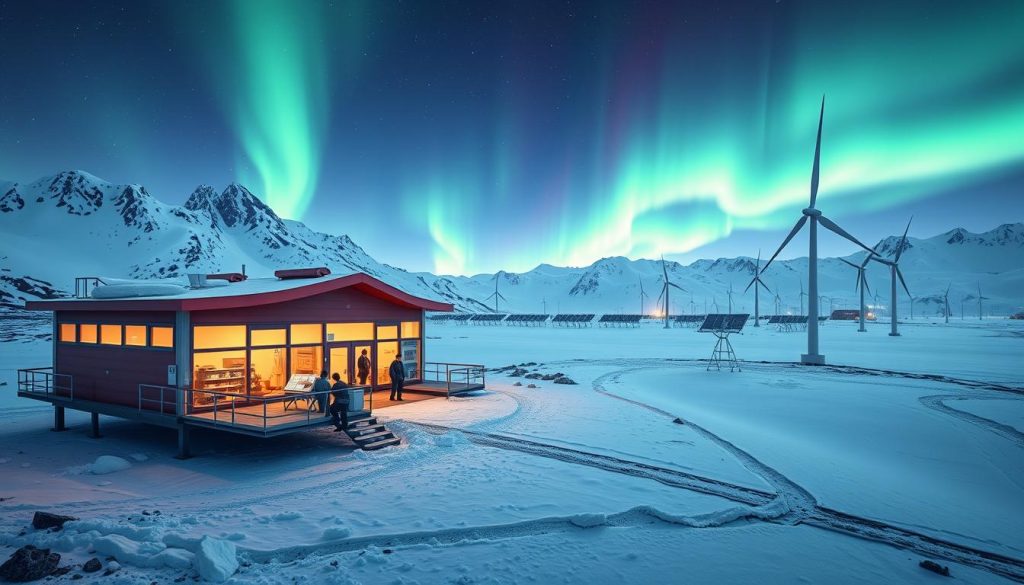
Antarctica is a hub for unique research, drawing experts from all over. Its untouched nature offers a perfect scene for studies on climate change, biodiversity, and ice samples. Here, development ventures push forward new ways to tackle key global issues.
Teams from universities, government bodies, and businesses work together here. They aim to tap into the rich research potential. By joining forces, they broaden their studies and make good use of various skills and resources. Key research topics include:
- Climate tracking and modelling to better understand global warming.
- Ecological studies on unique species endemic to the region.
- Geological research harnessing ice core samples for data on historical climate patterns.
Antarctica’s role in groundbreaking scientific discoveries is significant. With a focus on sustainability and protecting the environment, research here is ready to offer great insights. These could help the scientific world and society greatly.
Agricultural Innovations in Extreme Climates

Antarctica’s harsh climate challenges food production. Thankfully, agricultural innovations are making a difference. Hydroponics and vertical farming are key. These methods allow crops to grow without soil.
By doing this, we rely less on importing food. It makes living on the continent more self-sufficient. These innovations could shape the future of agriculture in Antarctica.
Hydroponics and Vertical Farming
Hydroponics and vertical farming open new doors for growing food in Antarctica. These methods use water rich in nutrients instead of soil. They also make the most of available space.
Key advantages include:
- Using fewer resources like water and fertiliser.
- Controlling the environment to ensure plants grow well.
- Being able to harvest fresh produce all year, no matter the weather.
Sustainable Practices for Cold Environments
For Antarctic farming to last, we need sustainable practices. These methods must work well in the cold. They include:
- Using renewable energy for farming.
- Recycling waste to protect nature.
- Incorporating local plants and animals into farming.
This approach to farming in cold places helps with food security. It also looks after our planet. This is vital for agriculture’s future in Antarctica.
Telecommunications and Digital Infrastructure
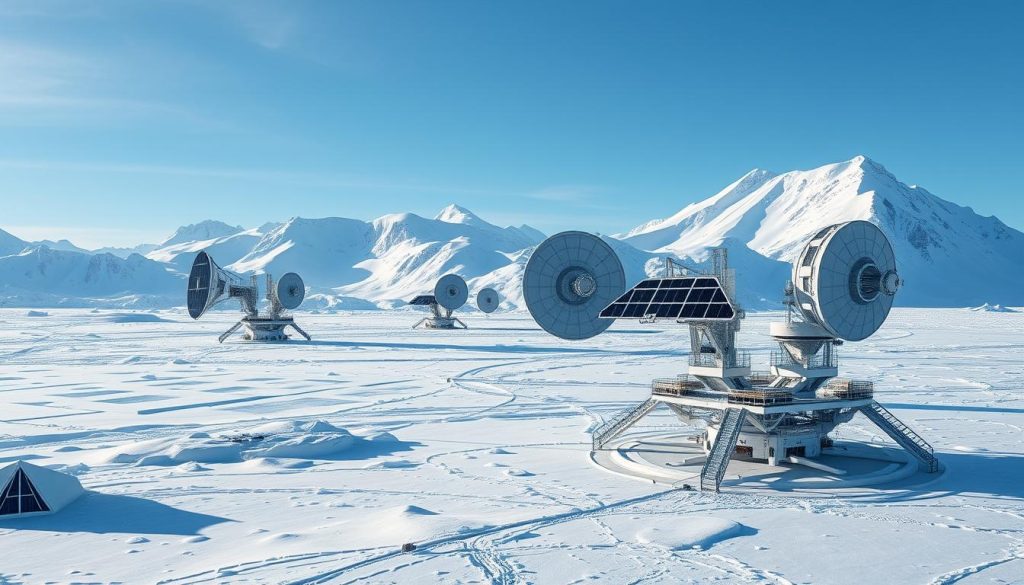
Antarctica’s tough geographic and weather conditions create big challenges for connectivity. The continent’s isolation makes building strong communication networks hard. Yet, reliable telecommunications are crucial for data sharing and teamwork among global research teams.
Challenges of Connectivity in Antarctica
Extreme weather is a big problem for telecommunications here. Harsh conditions often damage infrastructure, causing unreliable internet. Some other challenges are:
- Limited infrastructure due to remote locations.
- Environmental rules that limit development.
- The high costs of keeping communication systems running.
The Role of Satellite Technology
Satellite technology is key to solving these issues in Antarctica. It has greatly improved communication. Here’s how satellite technology helps:
- It boosts internet access, linking research stations smoothly.
- It allows real-time data sharing over long distances.
- It supports video calls and digital teamwork tools.
As we depend more on digital tools, investing in satellite technology becomes more important. It ensures the success of research and new businesses in Antarctica.
Marine and Oceanic Business Opportunities
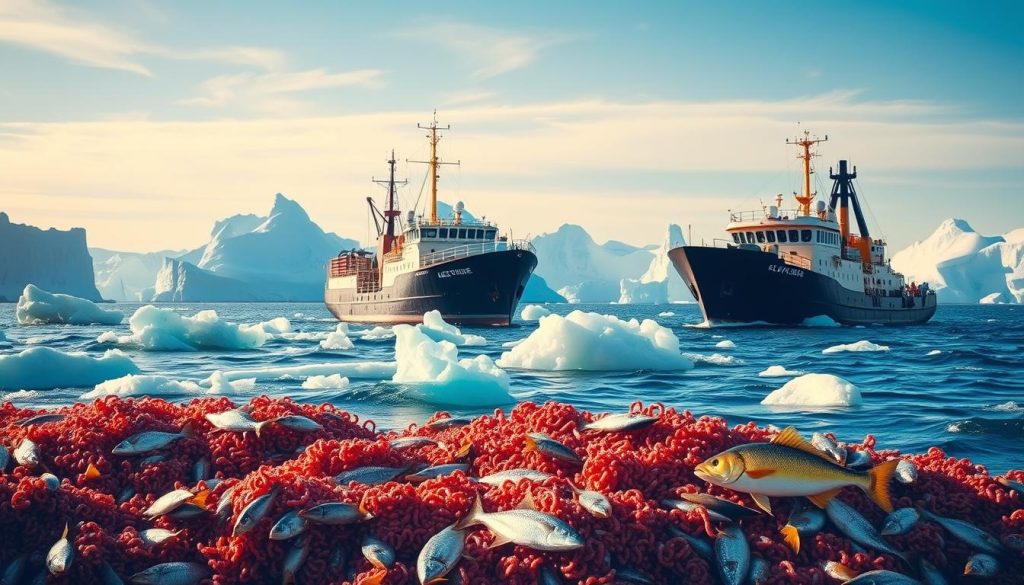
The sectors around Antarctica are ripe with business chances, especially in fishing. Strict rules ensure the fishing is done right, helping to keep sea life safe. Knowing these rules is key for businesses to do well in this special area.
Fishing Industry Regulations
The rules for fishing in Antarctica aim to protect the seas while allowing sensible fish catching. Important points include:
- Hard limits on catch sizes to avoid overfishing.
- Seasonal fishing breaks to let fish populations grow.
- Required reports and checks to follow global standards.
- A push for practices that care for the ocean’s future.
Marine Research Collaborations
Working together, governments and scientists make great strides in understanding the sea. These partnerships concentrate on:
- Joint efforts to check the health of our oceans.
- Creating new ways to fish without harm.
- Studying how changing weather affects sea life.
Logistics and Transport Challenges
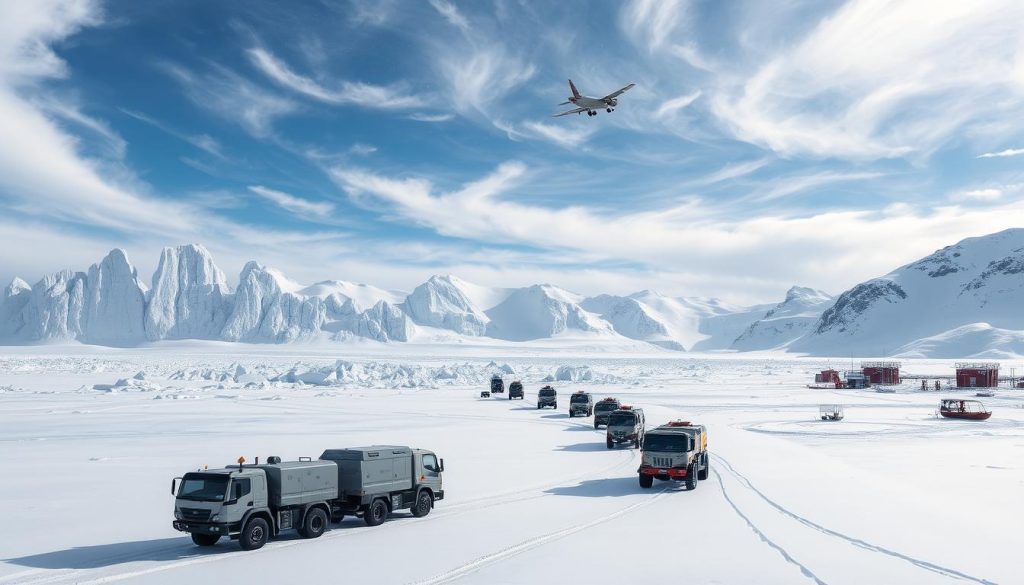
Doing business in Antarctica brings a unique mix of logistical and transport hurdles. The harsh environment needs reliable shipping and supply chains to keep operations smooth. It’s tough to move goods because of the icy seas and severe weather. Knowing the details of these logistical puzzles is crucial for doing well in this faraway place.
Shipping and Supply Chain Solutions
For work in Antarctica, having strong shipping plans is a must. Icebreakers are key, helping ships move through the ice. There are also special freight options like:
- Container ships made for cold conditions
- Yearly supply trips that work with research stations
- Working with local logistics firms to get better results
Shipping solutions in Antarctica need to use both physical methods and tech. This helps track shipments well and manage stock smartly. Good supply chain management helps avoid delays caused by the extreme conditions.
Innovative Transport Technologies
New transport tech can greatly improve how things work in Antarctica. Drones are great for delivering vital items to hard-to-reach spots quickly. Automated systems help handle stock and logistics, making Antarctic tasks less complicated. Taking up these new methods is key to tackling the logistical challenges in this exceptional place.
Environmental Considerations for Business in Antarctica
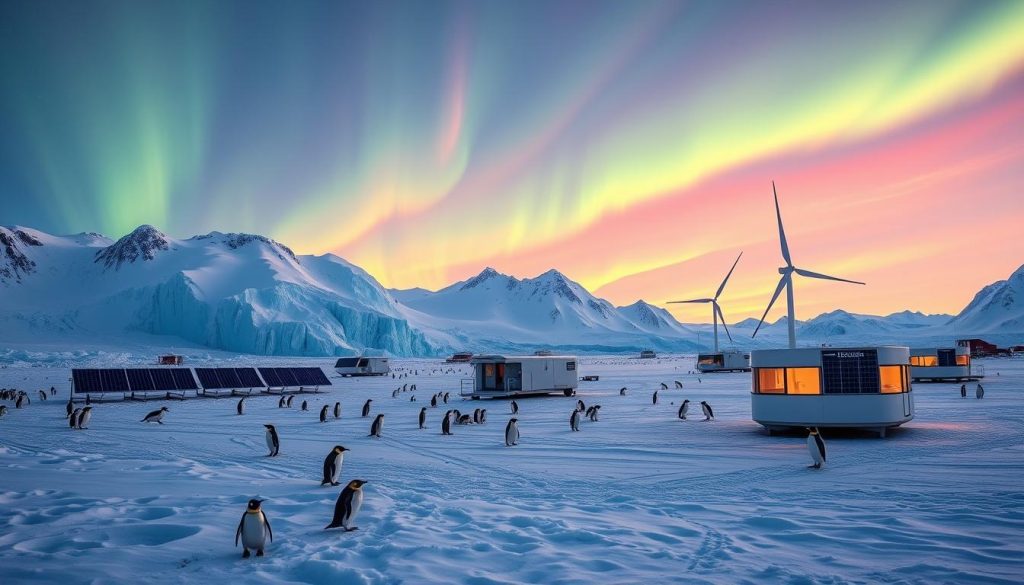
Exploring business in Antarctica requires a deep understanding of its environment. This area’s untouched ecosystem needs strict rules to keep its unique wildlife and habitats safe. It’s vital to follow international treaties to protect these sensitive areas, ensuring businesses don’t harm this special continent.
Complying with International Treaties
The Antarctic Treaty and its protocols lay out the rules for businesses. They must follow the Protocol on Environmental Protection to the Antarctic Treaty. This protocol has rules designed to save the environment. It includes:
- Doing Environmental Impact Assessments (EIAs) before starting projects.
- Setting up waste management systems to lower pollution.
- Being ready to stop any activity if it becomes necessary.
It’s crucial for companies to follow these rules if they want to work sustainably in this delicate ecosystem. Ignoring them can lead to big legal issues and damage the environment.
Sustainable Practices for Long-Term Success
For businesses to do well in Antarctica in the long run, they must focus on sustainability. This approach not only helps the environment but also makes companies more attractive. They should:
- Invest in green energy to cut down on carbon emissions.
- Use environmentally friendly materials in all their work.
- Work with scientists to make sure they use the best methods and innovations.
Focusing on protecting Antarctica’s environment lets businesses lessen their impact and grow economically. Choosing sustainable ways shows they care about making profits without ruining this pristine area.
Potential for Collaboration and Partnerships
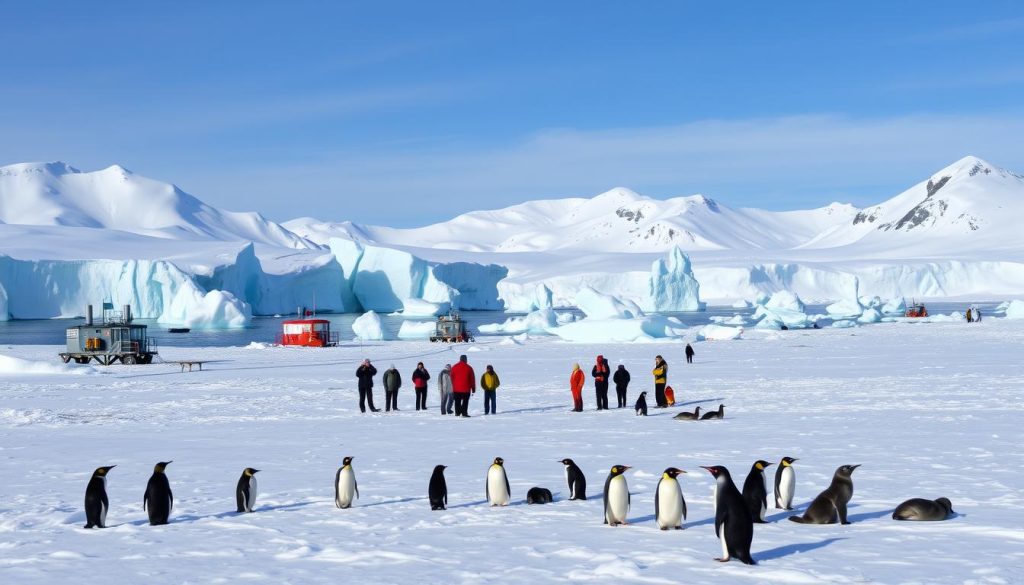
Antarctica is a special place for businesses to find partnership opportunities. Teaming up with Antarctic research stations brings new chances for innovation and sharing resources. This helps companies use advanced research to improve products and be more efficient. They gain access to deep knowledge which helps them work better in tough conditions.
Crossover with Antarctic Research Stations
Research stations are key for science and tech progress. Partnering with these stations offers many advantages, such as:
- Access to top facilities and equipment
- Working together on new research projects
- Chances for shared funding and grants
This environment encourages creativity, helping businesses tackle Antarctic challenges. It also helps them play a part in science and grow in the Antarctic market.
International Business Alliances
The chance for global business in Antarctica is growing. Companies from different countries can join forces to do better in this market. This has several benefits:
- Knowledge sharing on regulations and market trends
- Pooling resources to handle the tough Antarctic conditions
- Stronger supply chains with shared expertise
These global partnerships push for innovation and support sustainable Antarctic business growth.
Funding and Investment Strategies
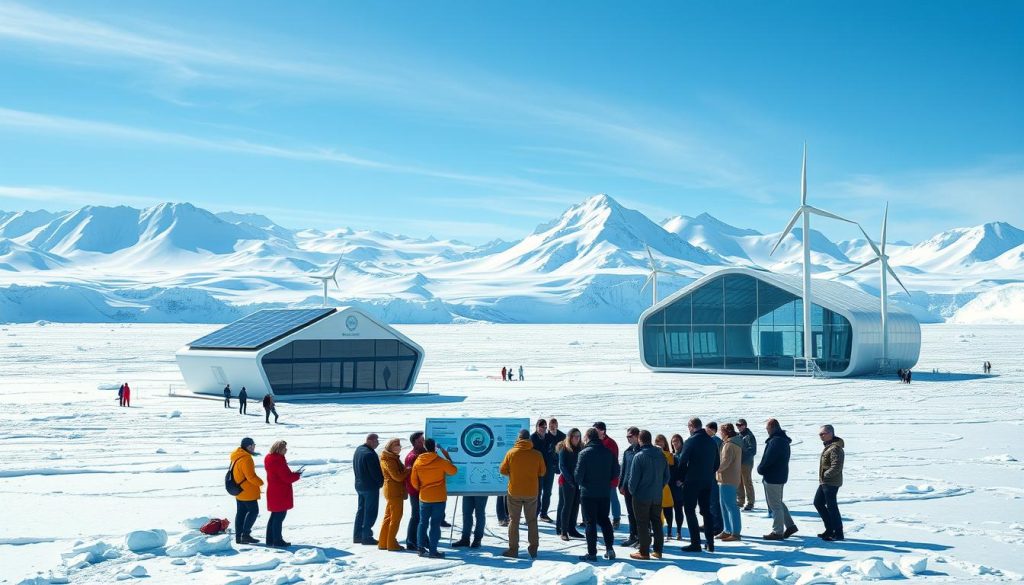
Entrepreneurs aiming to tap into Antarctica’s unique market can gain a lot from various funding chances. Grants and subsidies play a key role in promoting sustainable growth. They help bring about inventive answers suited to the harsh Antarctic conditions.
Grants and Subsidies for Entrepreneurs
Entrepreneurs in Antarctica have access to several grants designed to boost new projects. These funds are meant to support eco-friendly growth and stimulate expansion in crucial sectors. Highlights of funding in Antarctica include:
- Government grants focusing on protecting the environment.
- Funds for research and advancing new technological solutions.
- Subsidies through global partnerships for climate change projects.
Venture Capital in Extreme Markets
Venture capital is crucial for Antarctic enterprises ready to embrace high-risk ventures. This financial support is drawing attention for its potential in extreme markets. Knowing the investment scene is key to getting the needed funds and making ventures thrive. Venture capital in these settings covers:
- Investments in startups that work on renewable energy.
- Backing tech projects that overcome logistical hurdles.
- Partnerships focused on eco-friendly growth in cold regions.
Challenges Faced by Businesses in Antarctica
Antarctica is a tough place for businesses. The cold and storms there make it hard to work. Companies must plan carefully to keep safe and keep going. Being able to handle these tough conditions helps keep workers happy and productive.
Extreme Weather Conditions
In Antarctica, dealing with the extreme weather is a big challenge for businesses. The cold is serious, and storms can happen without warning. Making buildings and equipment that can handle this is key. This also leads to delays which affect how things run.
Companies have to get special gear and train their staff well. This helps them meet their goals while keeping everyone safe.
Regulatory Hurdles and Compliance
Businesses in Antarctica also face legal challenges. They have to follow international rules and standards. This means they need to know a lot about the laws there. For new businesses, this can be tough. It’s important to work with partners who know what they’re doing.
As rules keep changing, companies must stay up to date. This is needed for a business to last in such a far-off place.







